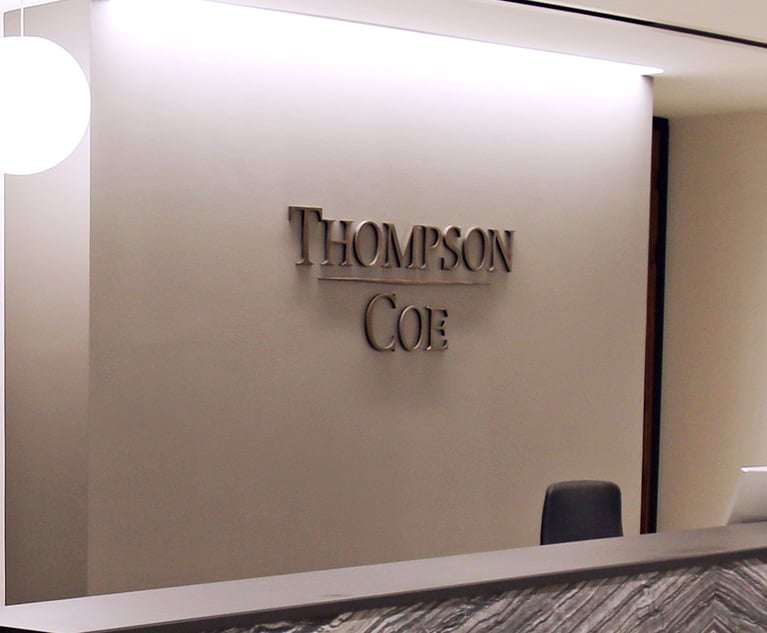Legal Marketing in the Time of COVID-19
What can we as a profession do to grow or, at the very least hold onto, business during the time of COVID-19?
March 17, 2020 at 11:56 AM
6 minute read

It sounds like a riddle someone in an old movie tells a group at a cocktail party: Imagine being in a world where personal contact is forbidden, and yet you need to retain your clients and possibly even grow your practice. How would you do it?
The riddle-teller rests their martini glass neatly on a coaster placed at the edge of an end table. In unison, the group chuckles. Fade to black.
The riddle is now reality and lawyers, marketers and their firms are trying to figure out how to adapt—and adapt fast. What can we as a profession do to grow or, at the very least hold onto, business during the time of COVID-19?
Individualized Attention
Dozens of law firms have already crafted memos to clients with the help of expert marketers. Many are beautifully scripted, detailing how the firms are adjusting to these challenging times. Many firms are allowing employees the ability to work remotely, and lawyers to remain accessible to their clients through an advanced technology stack that allows for a constant flow of work in, out and around the firm.
All of these memos are worthwhile and an important part of communicating internally and externally as to the resources that firms have deployed. However, a memo alone is not a solution. It is just one part of the equation. What a mass memo misses—what can't be addressed in prose—is the individual contact that lawyers need to have with their clients. Individual calls to clients, even if they are to say, "Hello, how are you doing? I wanted to check in and see how you/your family/team/firm are holding up during these times," are essential. The calls may develop into providing some IT support, or just providing a shoulder to lean on, but this is the time to engage.
Law firm leaders need to strategize, examining their lists of clients to ensure each regular client or each individual contact of the firm is reached. While the approach must be very individualized and up to the lawyers who have those relationships, the step of making that personal outreach shouldn't be left to chance. This is not a case where a firm's leadership should say, "I'll let all of the partners take care of this when and if they see it as being appropriate." This is a time when partners need support and guidance.
Leadership
Firm leaders must take a big role not only in steering their firms to stay safe, but steering the focus deeper from client service to client care. Whether that care comes in the form of helping a client ramp up their at-home capabilities ("Let me connect you with our IT folks who can talk you through how to set up Zoom at your house") to simply asking them how their family is doing, this is the time to do it.
Leaders must help to communicate this message to their lawyers by giving real examples of how it can be done. Lawyers tend to look for precedents, and for many this type of client care behavior is going to be unprecedented. We've all been through fire drills where the safety director says, "If the fire is above you, look for smoke, put the back of your hand on the door to feel for heat, and then go into the stairwell to walk down a few flights." This is a great example of step-by-step instructions, the type of detailed direction that firm partners and associates will need to hear from their leadership.
New Clients
You may be in the midst of RFPs or pitches and hopefully have well-honed procedures in place to produce these. Fortunately, for most larger firms, the days when a partner would send an all-partners memo asking, "Who in the firm has ever done X type of work?" are gone. If the firm hasn't updated their experience databases or their procedures for preparing new business research and pitches, now is the time to catch up with modernity and ensure that this process runs seamlessly.
Opportunities
"We're not ambulance chasers," I once heard a corporate lawyer remark when their marketer suggested there might be a way to track indicators for companies considering acquisitions. I always wanted to avoid looking at bad news, whether it was a stock market drop or an industry debacle, as an opportunity to develop business; however, it is important to be agile and to think creatively about how to help existing clients with new issues, or solve problems for new clients. For example, with existing clients, are there services we can provide to them, such as new clauses in agreements?
As for new business, within the next few months, we will see new developments as well as stresses on medical innovation, health care, hospitals, supply chain and consumer products. We may also see additional shifts in securities and financial products. Some firms will develop task forces to look at these changes and identify where there may be industries with new legal needs—the large company that, due to actuarial changes, needs to alter its sick-leave policy; the health care company that enters into a joint venture; the cruise line that sells off assets. They will all need lawyers. Firms need to have a concerted effort to look at the future and how these changes will affect their clients and will impact business.
Communications Technology
If firms are not up-to-speed on remote communications technologies, this is the time to get on board. Many clients will expect to meet with their lawyers online. Deploying these technologies does not have to be difficult. With app-based companies, technology can be downloaded remotely, and training sessions can be run online. With guidance from the firm as to how to properly run a videoconference meeting (along with a solid agenda and clear objectives) firms can use remote technology to do new business pitches as well as strategy meetings.
With various tools at their disposal and the intellect to adapt, law firms will steer themselves into the future.
Deborah B. Farone is a strategic adviser and author of "Best Practices in Law Firm Business Development and Marketing."
This content has been archived. It is available through our partners, LexisNexis® and Bloomberg Law.
To view this content, please continue to their sites.
Not a Lexis Subscriber?
Subscribe Now
Not a Bloomberg Law Subscriber?
Subscribe Now
NOT FOR REPRINT
© 2025 ALM Global, LLC, All Rights Reserved. Request academic re-use from www.copyright.com. All other uses, submit a request to [email protected]. For more information visit Asset & Logo Licensing.
You Might Like
View All
KPMG Wants to Provide Legal Services in the US. Now All Eyes Are on Their Big Four Peers



K&L Gates Sheds Space, but Will Stay in Flagship Pittsburgh Office After Lease Renewal
Trending Stories
- 1Fourth Circuit Seeks More Legal Briefs in Unresolved N.C. Supreme Court Election
- 2iRobot Picks Up Law Firm Partner as New Legal Chief
- 3Baker McKenzie Spins Off AI-Powered Risk Management Tool SCOREalytics as Independent Business
- 4Edison Hit With Lawsuits Over Devastating Eaton Fire in Los Angeles
- 5Does Society’s Focus on Children’s Sexuality Make Them Vulnerable to Grooming?
Who Got The Work
Michael G. Bongiorno, Andrew Scott Dulberg and Elizabeth E. Driscoll from Wilmer Cutler Pickering Hale and Dorr have stepped in to represent Symbotic Inc., an A.I.-enabled technology platform that focuses on increasing supply chain efficiency, and other defendants in a pending shareholder derivative lawsuit. The case, filed Oct. 2 in Massachusetts District Court by the Brown Law Firm on behalf of Stephen Austen, accuses certain officers and directors of misleading investors in regard to Symbotic's potential for margin growth by failing to disclose that the company was not equipped to timely deploy its systems or manage expenses through project delays. The case, assigned to U.S. District Judge Nathaniel M. Gorton, is 1:24-cv-12522, Austen v. Cohen et al.
Who Got The Work
Edmund Polubinski and Marie Killmond of Davis Polk & Wardwell have entered appearances for data platform software development company MongoDB and other defendants in a pending shareholder derivative lawsuit. The action, filed Oct. 7 in New York Southern District Court by the Brown Law Firm, accuses the company's directors and/or officers of falsely expressing confidence in the company’s restructuring of its sales incentive plan and downplaying the severity of decreases in its upfront commitments. The case is 1:24-cv-07594, Roy v. Ittycheria et al.
Who Got The Work
Amy O. Bruchs and Kurt F. Ellison of Michael Best & Friedrich have entered appearances for Epic Systems Corp. in a pending employment discrimination lawsuit. The suit was filed Sept. 7 in Wisconsin Western District Court by Levine Eisberner LLC and Siri & Glimstad on behalf of a project manager who claims that he was wrongfully terminated after applying for a religious exemption to the defendant's COVID-19 vaccine mandate. The case, assigned to U.S. Magistrate Judge Anita Marie Boor, is 3:24-cv-00630, Secker, Nathan v. Epic Systems Corporation.
Who Got The Work
David X. Sullivan, Thomas J. Finn and Gregory A. Hall from McCarter & English have entered appearances for Sunrun Installation Services in a pending civil rights lawsuit. The complaint was filed Sept. 4 in Connecticut District Court by attorney Robert M. Berke on behalf of former employee George Edward Steins, who was arrested and charged with employing an unregistered home improvement salesperson. The complaint alleges that had Sunrun informed the Connecticut Department of Consumer Protection that the plaintiff's employment had ended in 2017 and that he no longer held Sunrun's home improvement contractor license, he would not have been hit with charges, which were dismissed in May 2024. The case, assigned to U.S. District Judge Jeffrey A. Meyer, is 3:24-cv-01423, Steins v. Sunrun, Inc. et al.
Who Got The Work
Greenberg Traurig shareholder Joshua L. Raskin has entered an appearance for boohoo.com UK Ltd. in a pending patent infringement lawsuit. The suit, filed Sept. 3 in Texas Eastern District Court by Rozier Hardt McDonough on behalf of Alto Dynamics, asserts five patents related to an online shopping platform. The case, assigned to U.S. District Judge Rodney Gilstrap, is 2:24-cv-00719, Alto Dynamics, LLC v. boohoo.com UK Limited.
Featured Firms
Law Offices of Gary Martin Hays & Associates, P.C.
(470) 294-1674
Law Offices of Mark E. Salomone
(857) 444-6468
Smith & Hassler
(713) 739-1250










